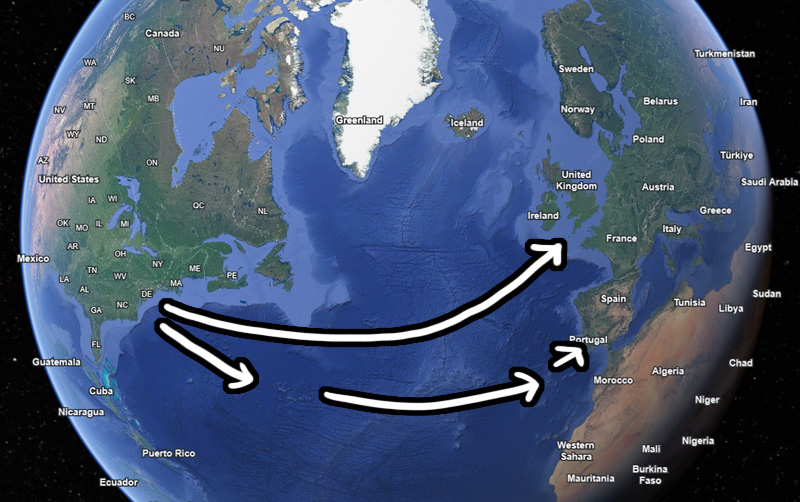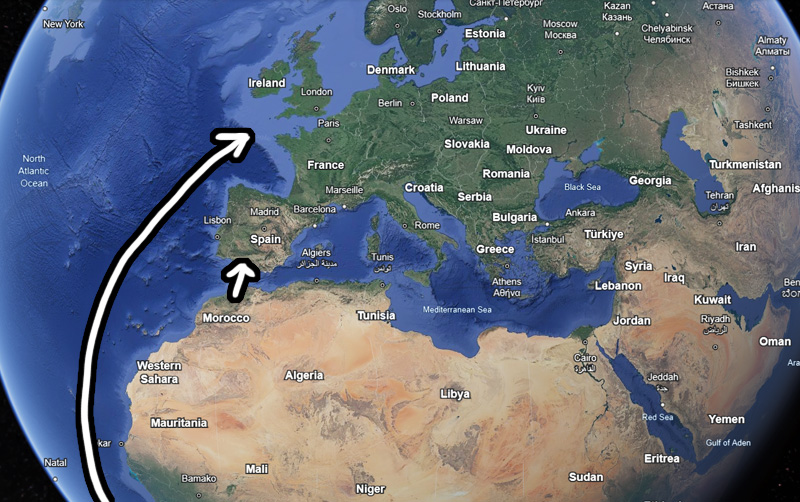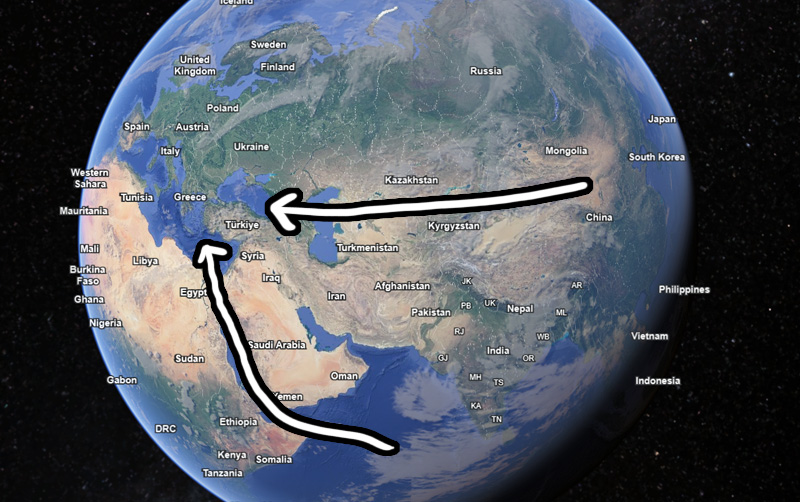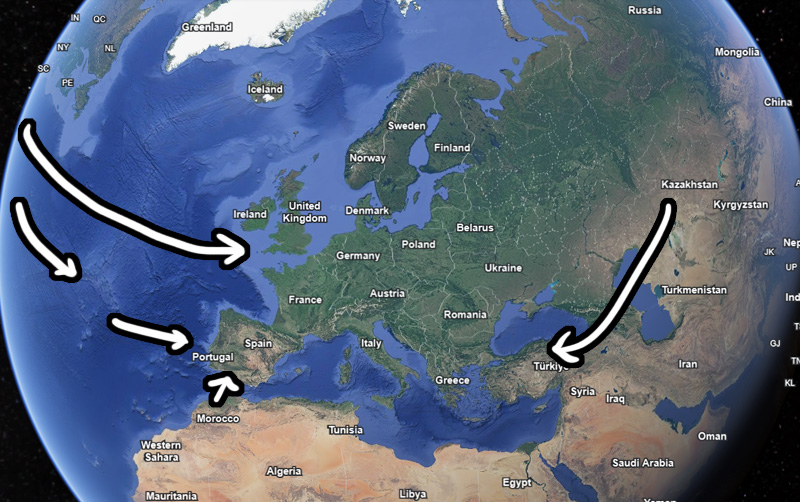How to get to Europe without flying? In this guide, we’ll explore flightless ways of reaching Europe from America, Africa, and Asia.
Can you travel to Europe without flying? Yes, you can! In this guide, we’ll go through different ways of reaching Europe without taking to the skies.
I have previously written similar guides for reaching Europe. This time around, we are exploring routes in the opposite direction.
See also:
- How to Take a Train from Europe to Asia (+ More Flightless Routes)
- How to Travel from Europe to Africa without Flying
- How to Travel from Europe to America by Ship
In the first section of this guide, I will talk about how to get from America to Europe without flying. In the middle chapter, we’ll navigate flightless routes from Africa to Europe. And finally, we’ll go through different overland routes starting from Asia.
As you go through this guide, you’ll see that traveling to Europe without comes with challenges. If you do decide to fly, please consider donating 10% of your ticket cost to an environmental nonprofit. Carbon offsetting isn’t very effective, so it’s better to support effective charities suggested by Giving Green instead.

How to Get from America to Europe without Flying
See also: How to Travel from USA to Europe by Ship
Taking a Transatlantic Cruise to Europe
When you think about flightless ways of reaching Europe from America, a transatlantic cruise might be the first option to come to your mind. It is indeed possible to take a transatlantic cruise to Europe. At the time of writing, I found over 200 transatlantic cruises from America to Europe.
The cheapest cruises from the United States to Europe start at around $1100-1500 for a cabin, including meals. For example, a 7-day voyage from New York to Southampton on the luxury cruise ship Queen Mary 2 starts at approximately $1400.
However, if you avoid flying for environmental reasons, you should note that cruises may actually produce significantly more CO2 emissions than flights.
Sailing Across the Atlantic
See also: How Long Does It Take to Sail the Atlantic?
It is possible to sail from America to Europe, although reverse journeys are more common due to the favorable trade winds. To begin a transatlantic sailing journey, it is popular to head to Bermuda or the Caribbean first.
According to Life of Sailing, an eastward crossing of the Atlantic takes around 4 weeks. This includes a week of sailing to Bermuda, two weeks or more from Bermuda to the Azores, and another week from the Azores to the coast of Portugal.
Even if you don’t own a sailboat or a yacht, you can hitch a ride on a boat across the Atlantic. Websites such as Crewseekers and Find a Crew connect captains with individuals willing to work as crewmates in exchange for the voyage.
Yacht clubs in harbors may also have notice boards for those seeking a boat or a crew. While many captains prefer crewmates with experience, it is not always necessary.
Taking a Cargo Ship from America to Europe
See also: How Long Does It Take a Cargo Ship to Cross the Atlantic?
Is it possible to travel on a cargo ship? Yes, it is! Even though I haven’t crossed the Atlantic on a cargo ship, I did travel from New Zealand to California on a freighter during my mostly flightless 2-year trip around the world.

On average, traveling on a cargo ship costs $100-150 per day. A transatlantic journey typically takes around 10-15 days, resulting in a total cost between $1000-3000. Popular freighter travel companies include Cargo Ship Voyages, Slowtravel, Voyages en Cargo, and Freighter Travel (NZ), which I personally used.
At the time of writing (Fall 2023), the COVID pandemic restrained the amount of cargo ship cruises available. Still, there are some freighter routes available. Here are a few examples:
- New York, USA, to Southampton, England – 7 days, ~$1000
- Miami, USA, to Algeciras, Spain – 11 days, ~$1400
- Mariel, Cuba, to Rotterdam, Netherlands – 3 weeks, ~$2900

Traveling from Africa to Europe without Flying
Routes Between Europe and Africa
Europe and Africa are separated by the Mediterranean Sea. The most narrow passage between the two continents is the Strait of Gibraltar. At its narrowest point, Europe and Africa are only 13 kilometers (8 miles) apart.
In the northeast, Africa is connected by the Sinai Peninsula land bridge to Asia. But even though it is possible to cross a land border from Egypt to Israel, political instability in the region makes continuing from Israel to Europe by land almost impossible.
Luckily, the Mediterranean Sea offers several crossing points between Europe and Africa. It is also possible to travel to enter Europe from other parts of Africa as a passenger on a cargo ship.
How to Get to Europe without Flying from Africa
There are plenty of ferry connections from Africa to Europe. For example, there are multiple daily ferries from Morocco to Spain. A ferry from Tanger Med in Morocco to Algeciras in Spain can take as little as 90 minutes and cost $20-30. You can also take a ferry from Tunisia to Italy in 18-30 hours for $50 or more.
A ferry connection from Cyprus to Alexandria in Egypt reopened in 2019. However, the route closed due to the COVID pandemic and hasn’t been reopened since.
Freighter travel is also possible, although the options are limited. From what I’ve seen, cargo ships that cross the Suez Canal don’t allow embarking in Africa. I also haven’t discovered any cargo ships that would take passengers from East Africa to Europe across the Canal.
In the past, there were more freighter travel options from Africa to Europe, but COVID has narrowed the options. At the time of writing, I could only discover routes from South Africa to Northern Europe. For example, a freighter voyage from Cape Town to Rotterdam (Netherlands) takes 27 days and costs approximately €3500.

Flightless Travel from Asia to Europe
Overland Routes from Asia to Europe
Finally, we will explore how to get to Europe without flying from Asia. As the two regions form the continental area of Eurasia, it comes as no surprise that there are many overland routes from Asia to Europe.
In the past, the Trans-Siberian and Trans-Mongolian railways were the easiest ways of traveling from Asia to Europe without flying. However, the current political situation has made these routes inaccessible for most people. The classic Hippie Trail is mostly off-limits for similar reasons.
Luckily there is some good news for overland travelers too. In early 2023, China resumed issuing tourist visas, making overland travel across the country possible once again.
One can travel across China and cross its western border to Kazakhstan. Steve from thetrip goeson.com has done this route several times, and he has written a guide for the overland crossing from China to Kazakhstan. After reaching Kazakhstan, you can navigate through Central and West Asia towards Turkey, the Black Sea, and Europe.
From Asia to Europe by Sea
Though not very popular, it is also possible to take a ship from Asia to Europe. For sailors, there are two possible routes: sailing around Africa via the Cape of Good Hope, or sailing across the Suez Canal from the Red Sea to the Mediterranean.
Both of these routes require plenty of time and effort. While the Suez Canal can be crossed in a day, sailing around Africa on the Cape Route takes weeks. This guide offers some information about sailing around Africa.
Despite the shorter duration, the Suez Canal route comes with its own challenges. Here is one entertaining story about the challenges of sailing the Suez Canal.
Perhaps surprisingly, there are more options for freighter travel from Asia to Europe than the other way around. From what I’ve seen, some container ships leaving Europe do a counterclockwise loop in the Indian Ocean, heading to Australia first before returning along the coast of Asia.
Here are few example cargo ship routes from Asia to Europe:
- Colombo (Sri Lanka) to Gioia Tauro (Italy) – 16 days, ~$2000
- Singapore to Barcelona (Spain) – 21 days, ~$2700

How to Get to Europe without Flying – A Summary
Can you travel to Europe without flying? In this guide, we have explored various flightless ways to travel from different continents to Europe.
Dozens of transatlantic cruises serve between America and Europe. However, cruises can produce significant CO2 emissions. Sailing across the Atlantic is also an option, with journeys lasting about 4 weeks. Traveling on cargo ships is also possible, with costs ranging from $100-150 per day.
It is possible to travel from Africa to Europe by ferry. Popular routes head from Morocco to Spain and Tunisia to Italy. Political factors limit overland travel through the Middle East. If you want to travel from Africa to Europe on a cargo ship, South Africa is the best place to start.
Lastly, we explored overland routes from Asia to Europe. While Russia remains inaccessible for most people, China has resumed issuing tourist visas, allowing overland travel through the country. Sailing from Asia to Europe is also an option, either around Africa’s Cape of Good Hope or through the Suez Canal.
Whether by sea, rail, or road, there are many ways of reaching Europe without flying. All these options come with their own benefits and challenges – and they all offer opportunities for everlasting memories.





2 comments
Terrific reporting, Arimo! I love that you’ve carved out a specific, sustainable, travel niche with this website. A great resource for long haul travelers seeking lower impact and more unique experiences!
Thank you Glenn! 🙂 Yes, it’s been fun to keep this platform evolving, and I really like the way it is now.